FIAT 124 SPIDER 2021 Owner handbook (in English)
Manufacturer: FIAT, Model Year: 2021, Model line: 124 SPIDER, Model: FIAT 124 SPIDER 2021Pages: 228, PDF Size: 5.08 MB
Page 171 of 228
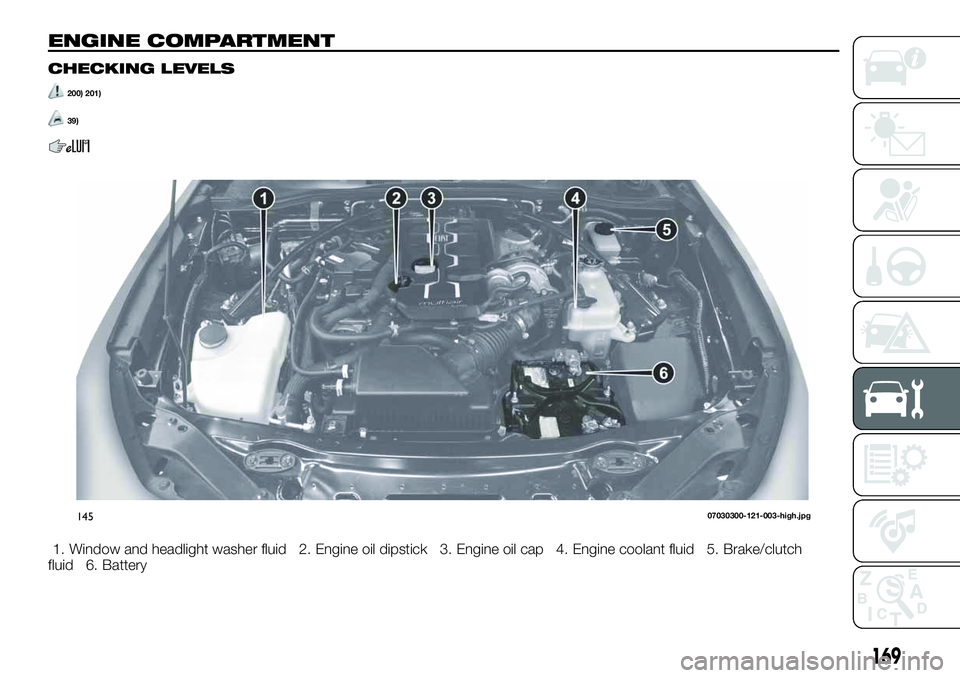
ENGINE COMPARTMENT
CHECKING LEVELS
200) 201)
39)
1. Window and headlight washer fluid 2. Engine oil dipstick 3. Engine oil cap 4. Engine coolant fluid 5. Brake/clutch
fluid 6. Battery
14507030300-121-003-high.jpg
169
Page 172 of 228
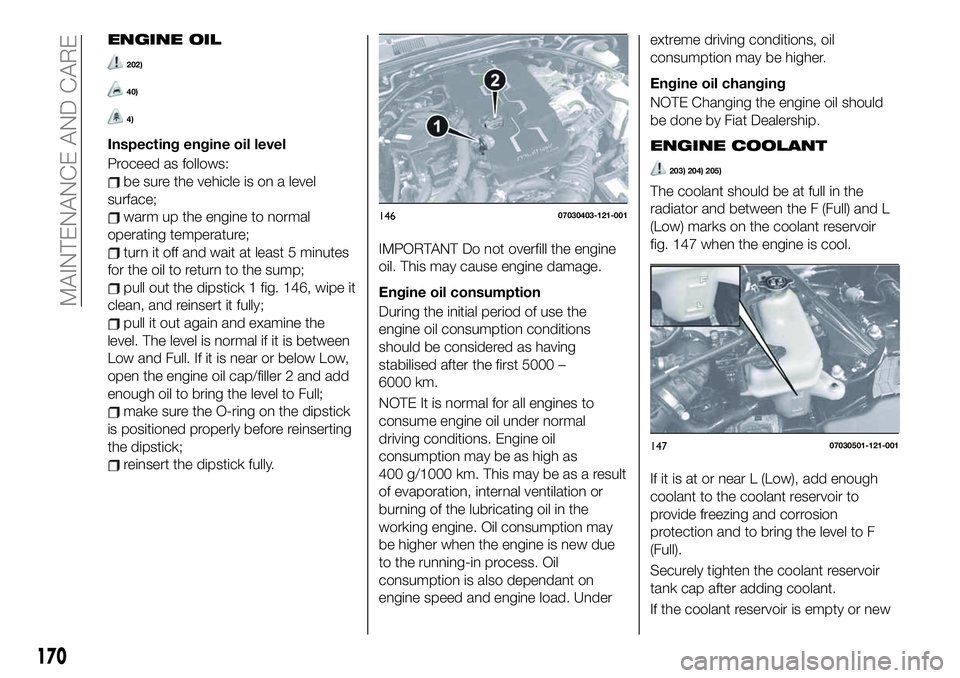
ENGINE OIL
202)
40)
4)
Inspecting engine oil level
Proceed as follows:
be sure the vehicle is on a level
surface;
warm up the engine to normal
operating temperature;
turn it off and wait at least 5 minutes
for the oil to return to the sump;
pull out the dipstick 1 fig. 146, wipe it
clean, and reinsert it fully;
pull it out again and examine the
level. The level is normal if it is between
Low and Full. If it is near or below Low,
open the engine oil cap/filler 2 and add
enough oil to bring the level to Full;
make sure the O-ring on the dipstick
is positioned properly before reinserting
the dipstick;
reinsert the dipstick fully.
IMPORTANT Do not overfill the engine
oil. This may cause engine damage.
Engine oil consumption
During the initial period of use the
engine oil consumption conditions
should be considered as having
stabilised after the first 5000 –
6000 km.
NOTE It is normal for all engines to
consume engine oil under normal
driving conditions. Engine oil
consumption may be as high as
400 g/1000 km. This may be as a result
of evaporation, internal ventilation or
burning of the lubricating oil in the
working engine. Oil consumption may
be higher when the engine is new due
to the running-in process. Oil
consumption is also dependant on
engine speed and engine load. Underextreme driving conditions, oil
consumption may be higher.
Engine oil changing
NOTE Changing the engine oil should
be done by Fiat Dealership.
ENGINE COOLANT
203) 204) 205)
The coolant should be at full in the
radiator and between the F (Full) and L
(Low) marks on the coolant reservoir
fig. 147 when the engine is cool.
If it is at or near L (Low), add enough
coolant to the coolant reservoir to
provide freezing and corrosion
protection and to bring the level to F
(Full).
Securely tighten the coolant reservoir
tank cap after adding coolant.
If the coolant reservoir is empty or new
14607030403-121-001
14707030501-121-001
170
MAINTENANCE AND CARE
Page 173 of 228
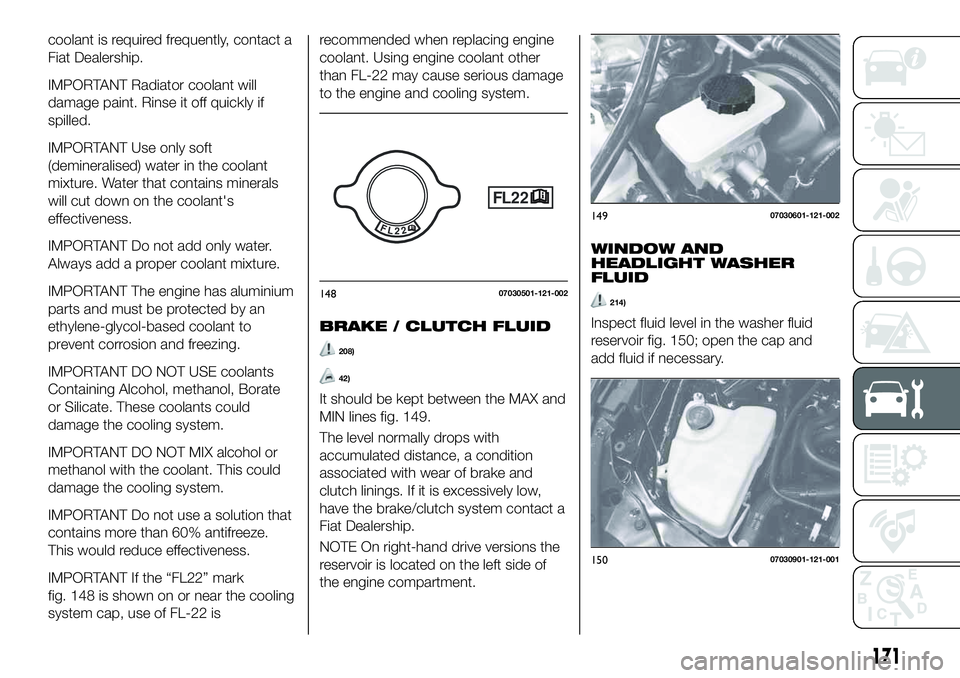
coolant is required frequently, contact a
Fiat Dealership.
IMPORTANT Radiator coolant will
damage paint. Rinse it off quickly if
spilled.
IMPORTANT Use only soft
(demineralised) water in the coolant
mixture. Water that contains minerals
will cut down on the coolant's
effectiveness.
IMPORTANT Do not add only water.
Always add a proper coolant mixture.
IMPORTANT The engine has aluminium
parts and must be protected by an
ethylene-glycol-based coolant to
prevent corrosion and freezing.
IMPORTANT DO NOT USE coolants
Containing Alcohol, methanol, Borate
or Silicate. These coolants could
damage the cooling system.
IMPORTANT DO NOT MIX alcohol or
methanol with the coolant. This could
damage the cooling system.
IMPORTANT Do not use a solution that
contains more than 60% antifreeze.
This would reduce effectiveness.
IMPORTANT If the “FL22” mark
fig. 148 is shown on or near the cooling
system cap, use of FL-22 isrecommended when replacing engine
coolant. Using engine coolant other
than FL-22 may cause serious damage
to the engine and cooling system.
BRAKE / CLUTCH FLUID
208)
42)
It should be kept between the MAX and
MIN lines fig. 149.
The level normally drops with
accumulated distance, a condition
associated with wear of brake and
clutch linings. If it is excessively low,
have the brake/clutch system contact a
Fiat Dealership.
NOTE On right-hand drive versions the
reservoir is located on the left side of
the engine compartment.
WINDOW AND
HEADLIGHT WASHER
FLUID
214)
Inspect fluid level in the washer fluid
reservoir fig. 150; open the cap and
add fluid if necessary.
14807030501-121-002
14907030601-121-002
15007030901-121-001
171
Page 174 of 228
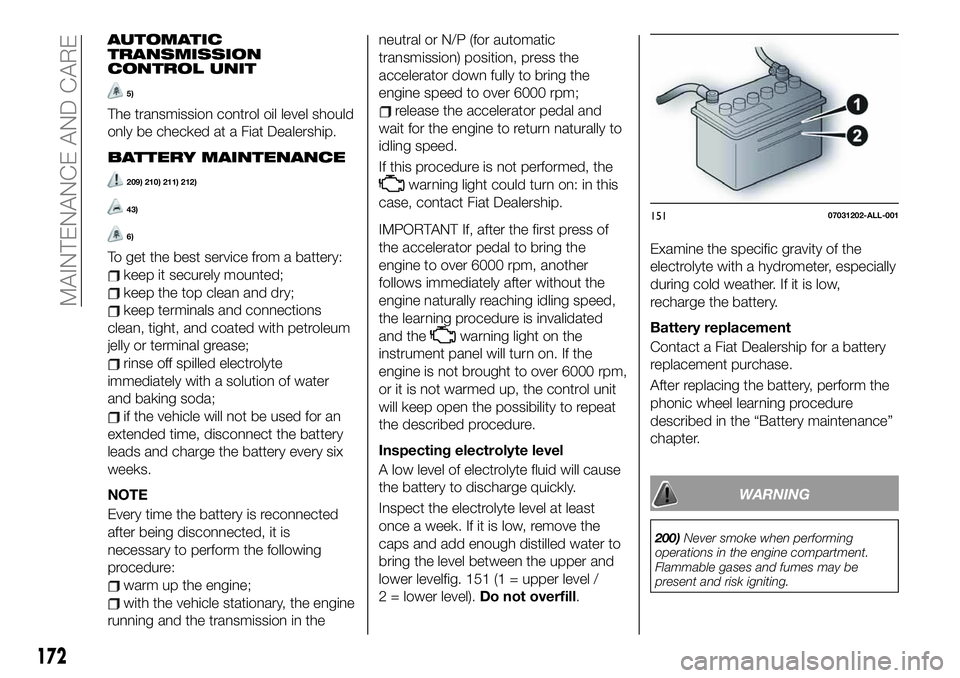
AUTOMATIC
TRANSMISSION
CONTROL UNIT
5)
The transmission control oil level should
only be checked at a Fiat Dealership.
BATTERY MAINTENANCE
209) 210) 211) 212)
43)
6)
To get the best service from a battery:
keep it securely mounted;
keep the top clean and dry;
keep terminals and connections
clean, tight, and coated with petroleum
jelly or terminal grease;
rinse off spilled electrolyte
immediately with a solution of water
and baking soda;
if the vehicle will not be used for an
extended time, disconnect the battery
leads and charge the battery every six
weeks.
NOTE
Every time the battery is reconnected
after being disconnected, it is
necessary to perform the following
procedure:
warm up the engine;
with the vehicle stationary, the engine
running and the transmission in theneutral or N/P (for automatic
transmission) position, press the
accelerator down fully to bring the
engine speed to over 6000 rpm;
release the accelerator pedal and
wait for the engine to return naturally to
idling speed.
If this procedure is not performed, the
warning light could turn on: in this
case, contact Fiat Dealership.
IMPORTANT If, after the first press of
the accelerator pedal to bring the
engine to over 6000 rpm, another
follows immediately after without the
engine naturally reaching idling speed,
the learning procedure is invalidated
and the
warning light on the
instrument panel will turn on. If the
engine is not brought to over 6000 rpm,
or it is not warmed up, the control unit
will keep open the possibility to repeat
the described procedure.
Inspecting electrolyte level
A low level of electrolyte fluid will cause
the battery to discharge quickly.
Inspect the electrolyte level at least
once a week. If it is low, remove the
caps and add enough distilled water to
bring the level between the upper and
lower levelfig. 151 (1 = upper level /
2 = lower level).Do not overfill.Examine the specific gravity of the
electrolyte with a hydrometer, especially
during cold weather. If it is low,
recharge the battery.
Battery replacement
Contact a Fiat Dealership for a battery
replacement purchase.
After replacing the battery, perform the
phonic wheel learning procedure
described in the “Battery maintenance”
chapter.
WARNING
200)Never smoke when performing
operations in the engine compartment.
Flammable gases and fumes may be
present and risk igniting.
15107031202-ALL-001
172
MAINTENANCE AND CARE
Page 175 of 228
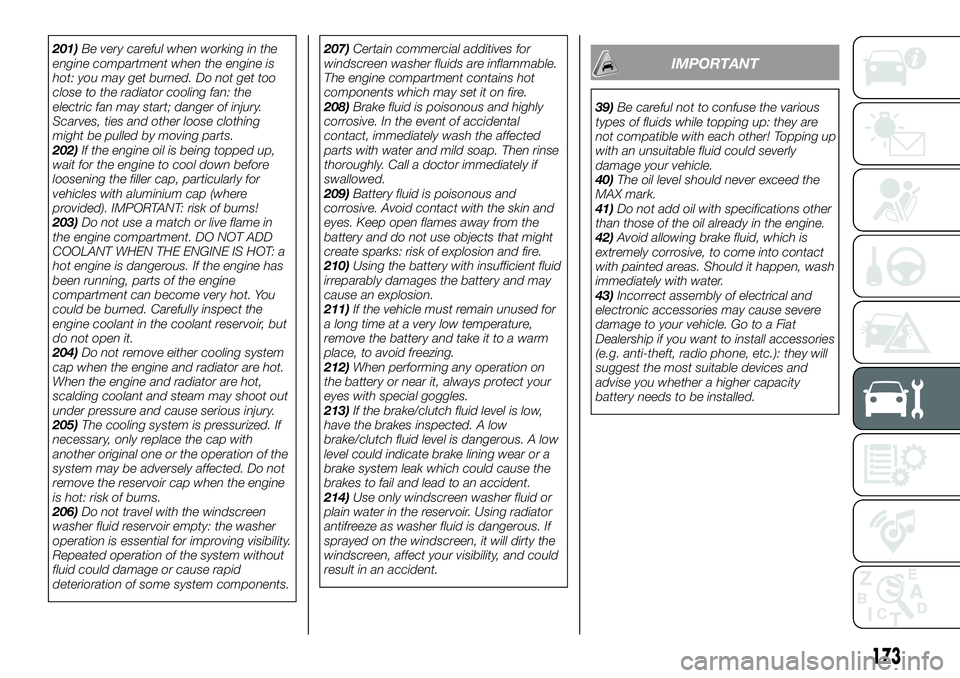
201)Be very careful when working in the
engine compartment when the engine is
hot: you may get burned. Do not get too
close to the radiator cooling fan: the
electric fan may start; danger of injury.
Scarves, ties and other loose clothing
might be pulled by moving parts.
202)If the engine oil is being topped up,
wait for the engine to cool down before
loosening the filler cap, particularly for
vehicles with aluminium cap (where
provided). IMPORTANT: risk of burns!
203)Do not use a match or live flame in
the engine compartment. DO NOT ADD
COOLANT WHEN THE ENGINE IS HOT: a
hot engine is dangerous. If the engine has
been running, parts of the engine
compartment can become very hot. You
could be burned. Carefully inspect the
engine coolant in the coolant reservoir, but
do not open it.
204)Do not remove either cooling system
cap when the engine and radiator are hot.
When the engine and radiator are hot,
scalding coolant and steam may shoot out
under pressure and cause serious injury.
205)The cooling system is pressurized. If
necessary, only replace the cap with
another original one or the operation of the
system may be adversely affected. Do not
remove the reservoir cap when the engine
is hot: risk of burns.
206)Do not travel with the windscreen
washer fluid reservoir empty: the washer
operation is essential for improving visibility.
Repeated operation of the system without
fluid could damage or cause rapid
deterioration of some system components.207)Certain commercial additives for
windscreen washer fluids are inflammable.
The engine compartment contains hot
components which may set it on fire.
208)Brake fluid is poisonous and highly
corrosive. In the event of accidental
contact, immediately wash the affected
parts with water and mild soap. Then rinse
thoroughly. Call a doctor immediately if
swallowed.
209)Battery fluid is poisonous and
corrosive. Avoid contact with the skin and
eyes. Keep open flames away from the
battery and do not use objects that might
create sparks: risk of explosion and fire.
210)Using the battery with insufficient fluid
irreparably damages the battery and may
cause an explosion.
211)If the vehicle must remain unused for
a long time at a very low temperature,
remove the battery and take it to a warm
place, to avoid freezing.
212)When performing any operation on
the battery or near it, always protect your
eyes with special goggles.
213)If the brake/clutch fluid level is low,
have the brakes inspected. A low
brake/clutch fluid level is dangerous. A low
level could indicate brake lining wear or a
brake system leak which could cause the
brakes to fail and lead to an accident.
214)Use only windscreen washer fluid or
plain water in the reservoir. Using radiator
antifreeze as washer fluid is dangerous. If
sprayed on the windscreen, it will dirty the
windscreen, affect your visibility, and could
result in an accident.IMPORTANT
39)Be careful not to confuse the various
types of fluids while topping up: they are
not compatible with each other! Topping up
with an unsuitable fluid could severly
damage your vehicle.
40)The oil level should never exceed the
MAX mark.
41)Do not add oil with specifications other
than those of the oil already in the engine.
42)Avoid allowing brake fluid, which is
extremely corrosive, to come into contact
with painted areas. Should it happen, wash
immediately with water.
43)Incorrect assembly of electrical and
electronic accessories may cause severe
damage to your vehicle. Go to a Fiat
Dealership if you want to install accessories
(e.g. anti-theft, radio phone, etc.): they will
suggest the most suitable devices and
advise you whether a higher capacity
battery needs to be installed.
173
Page 176 of 228
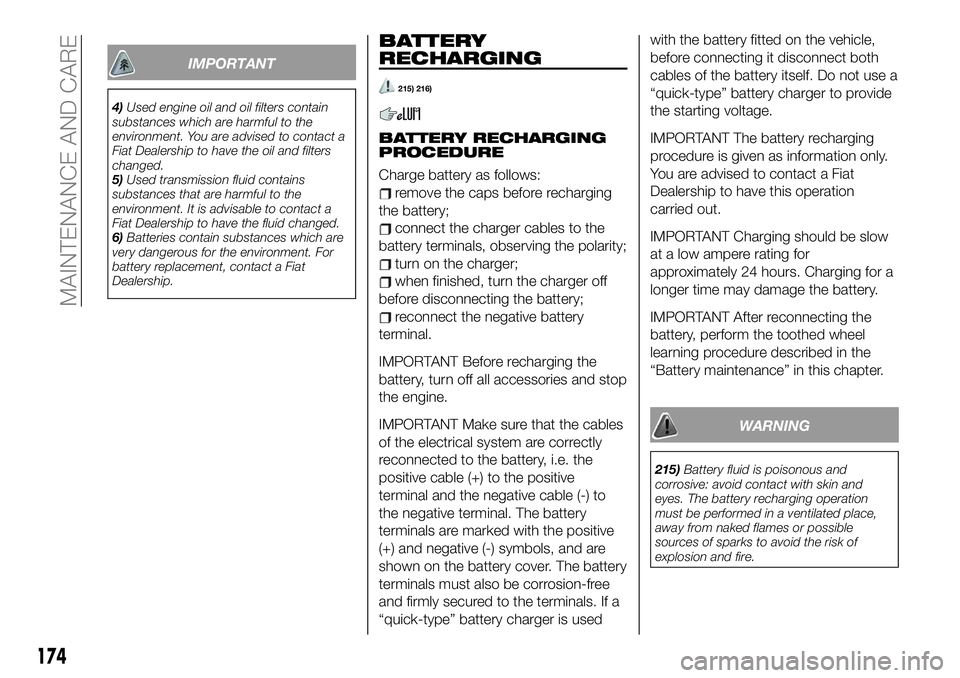
IMPORTANT
4)Used engine oil and oil filters contain
substances which are harmful to the
environment. You are advised to contact a
Fiat Dealership to have the oil and filters
changed.
5)Used transmission fluid contains
substances that are harmful to the
environment. It is advisable to contact a
Fiat Dealership to have the fluid changed.
6)Batteries contain substances which are
very dangerous for the environment. For
battery replacement, contact a Fiat
Dealership.
BATTERY
RECHARGING
215) 216)
BATTERY RECHARGING
PROCEDURE
Charge battery as follows:
remove the caps before recharging
the battery;
connect the charger cables to the
battery terminals, observing the polarity;
turn on the charger;
when finished, turn the charger off
before disconnecting the battery;
reconnect the negative battery
terminal.
IMPORTANT Before recharging the
battery, turn off all accessories and stop
the engine.
IMPORTANT Make sure that the cables
of the electrical system are correctly
reconnected to the battery, i.e. the
positive cable (+) to the positive
terminal and the negative cable (-) to
the negative terminal. The battery
terminals are marked with the positive
(+) and negative (-) symbols, and are
shown on the battery cover. The battery
terminals must also be corrosion-free
and firmly secured to the terminals. If a
“quick-type” battery charger is usedwith the battery fitted on the vehicle,
before connecting it disconnect both
cables of the battery itself. Do not use a
“quick-type” battery charger to provide
the starting voltage.
IMPORTANT The battery recharging
procedure is given as information only.
You are advised to contact a Fiat
Dealership to have this operation
carried out.
IMPORTANT Charging should be slow
at a low ampere rating for
approximately 24 hours. Charging for a
longer time may damage the battery.
IMPORTANT After reconnecting the
battery, perform the toothed wheel
learning procedure described in the
“Battery maintenance” in this chapter.
WARNING
215)Battery fluid is poisonous and
corrosive: avoid contact with skin and
eyes. The battery recharging operation
must be performed in a ventilated place,
away from naked flames or possible
sources of sparks to avoid the risk of
explosion and fire.
174
MAINTENANCE AND CARE
Page 177 of 228
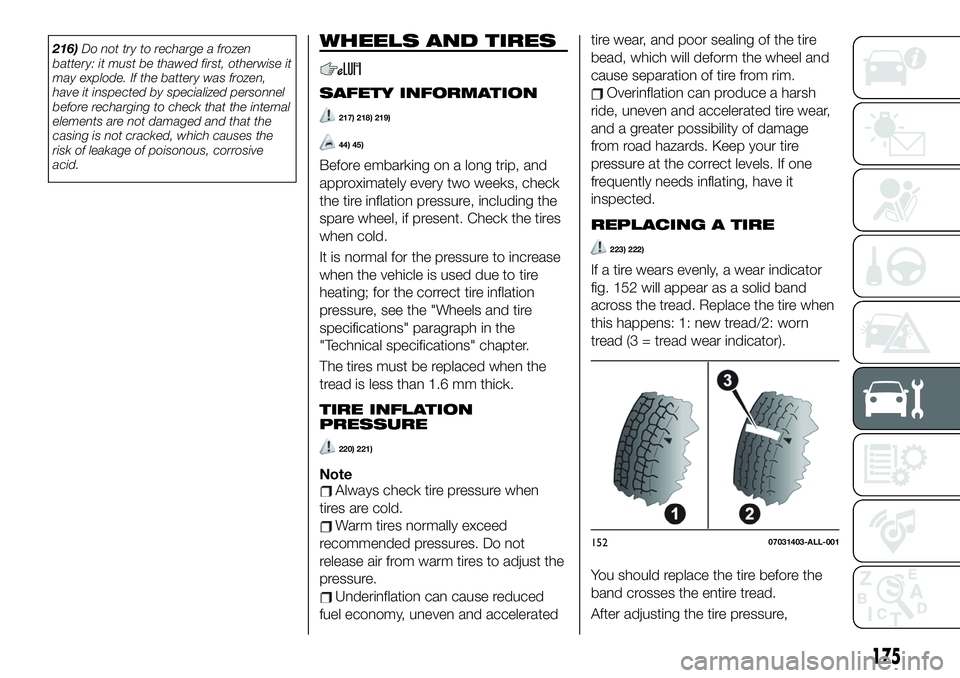
216)Do not try to recharge a frozen
battery: it must be thawed first, otherwise it
may explode. If the battery was frozen,
have it inspected by specialized personnel
before recharging to check that the internal
elements are not damaged and that the
casing is not cracked, which causes the
risk of leakage of poisonous, corrosive
acid.WHEELS AND TIRES
SAFETY INFORMATION
217) 218) 219)
44) 45)
Before embarking on a long trip, and
approximately every two weeks, check
the tire inflation pressure, including the
spare wheel, if present. Check the tires
when cold.
It is normal for the pressure to increase
when the vehicle is used due to tire
heating; for the correct tire inflation
pressure, see the "Wheels and tire
specifications" paragraph in the
"Technical specifications" chapter.
The tires must be replaced when the
tread is less than 1.6 mm thick.
TIRE INFLATION
PRESSURE
220) 221)
NoteAlways check tire pressure when
tires are cold.
Warm tires normally exceed
recommended pressures. Do not
release air from warm tires to adjust the
pressure.
Underinflation can cause reduced
fuel economy, uneven and acceleratedtire wear, and poor sealing of the tire
bead, which will deform the wheel and
cause separation of tire from rim.
Overinflation can produce a harsh
ride, uneven and accelerated tire wear,
and a greater possibility of damage
from road hazards. Keep your tire
pressure at the correct levels. If one
frequently needs inflating, have it
inspected.
REPLACING A TIRE
223) 222)
If a tire wears evenly, a wear indicator
fig. 152 will appear as a solid band
across the tread. Replace the tire when
this happens: 1: new tread/2: worn
tread (3 = tread wear indicator).
You should replace the tire before the
band crosses the entire tread.
After adjusting the tire pressure,
15207031403-ALL-001
175
Page 178 of 228
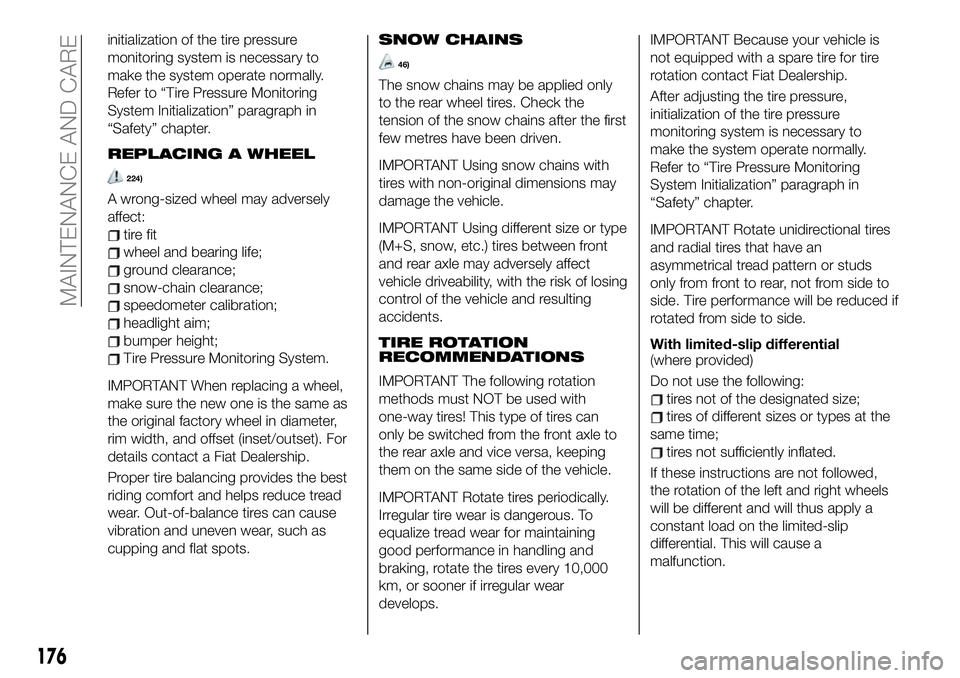
initialization of the tire pressure
monitoring system is necessary to
make the system operate normally.
Refer to “Tire Pressure Monitoring
System Initialization” paragraph in
“Safety” chapter.
REPLACING A WHEEL
224)
A wrong-sized wheel may adversely
affect:
tire fit
wheel and bearing life;
ground clearance;
snow-chain clearance;
speedometer calibration;
headlight aim;
bumper height;
Tire Pressure Monitoring System.
IMPORTANT When replacing a wheel,
make sure the new one is the same as
the original factory wheel in diameter,
rim width, and offset (inset/outset). For
details contact a Fiat Dealership.
Proper tire balancing provides the best
riding comfort and helps reduce tread
wear. Out-of-balance tires can cause
vibration and uneven wear, such as
cupping and flat spots.
SNOW CHAINS
46)
The snow chains may be applied only
to the rear wheel tires. Check the
tension of the snow chains after the first
few metres have been driven.
IMPORTANT Using snow chains with
tires with non-original dimensions may
damage the vehicle.
IMPORTANT Using different size or type
(M+S, snow, etc.) tires between front
and rear axle may adversely affect
vehicle driveability, with the risk of losing
control of the vehicle and resulting
accidents.
TIRE ROTATION
RECOMMENDATIONS
IMPORTANT The following rotation
methods must NOT be used with
one-way tires! This type of tires can
only be switched from the front axle to
the rear axle and vice versa, keeping
them on the same side of the vehicle.
IMPORTANT Rotate tires periodically.
Irregular tire wear is dangerous. To
equalize tread wear for maintaining
good performance in handling and
braking, rotate the tires every 10,000
km, or sooner if irregular wear
develops.IMPORTANT Because your vehicle is
not equipped with a spare tire for tire
rotation contact Fiat Dealership.
After adjusting the tire pressure,
initialization of the tire pressure
monitoring system is necessary to
make the system operate normally.
Refer to “Tire Pressure Monitoring
System Initialization” paragraph in
“Safety” chapter.
IMPORTANT Rotate unidirectional tires
and radial tires that have an
asymmetrical tread pattern or studs
only from front to rear, not from side to
side. Tire performance will be reduced if
rotated from side to side.
With limited-slip differential
(where provided)
Do not use the following:
tires not of the designated size;
tires of different sizes or types at the
same time;
tires not sufficiently inflated.
If these instructions are not followed,
the rotation of the left and right wheels
will be different and will thus apply a
constant load on the limited-slip
differential. This will cause a
malfunction.
176
MAINTENANCE AND CARE
Page 179 of 228
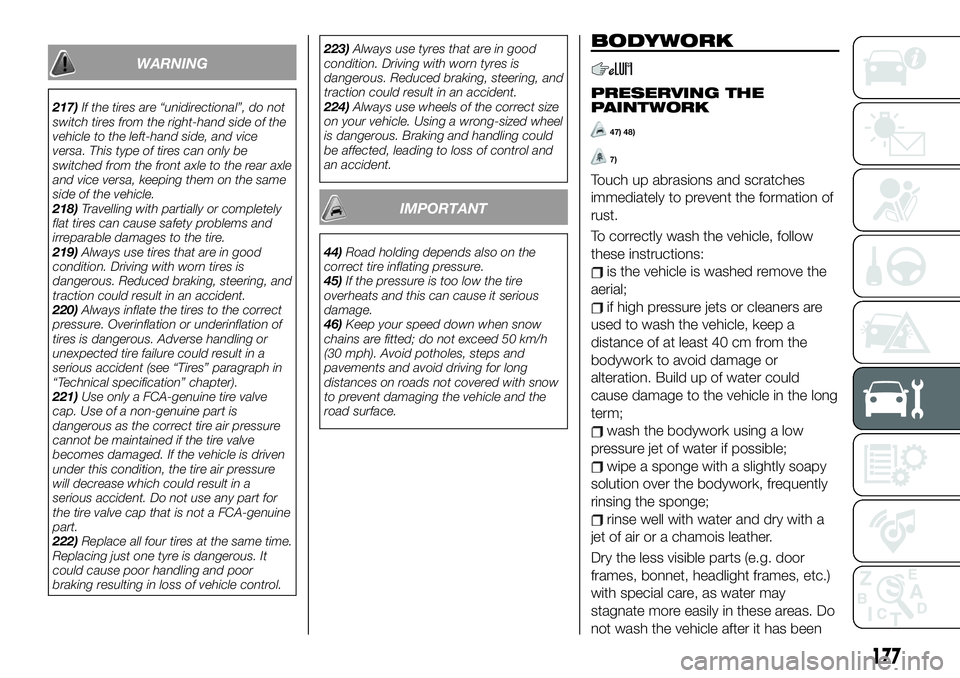
WARNING
217)If the tires are “unidirectional”, do not
switch tires from the right-hand side of the
vehicle to the left-hand side, and vice
versa. This type of tires can only be
switched from the front axle to the rear axle
and vice versa, keeping them on the same
side of the vehicle.
218)Travelling with partially or completely
flat tires can cause safety problems and
irreparable damages to the tire.
219)Always use tires that are in good
condition. Driving with worn tires is
dangerous. Reduced braking, steering, and
traction could result in an accident.
220)Always inflate the tires to the correct
pressure. Overinflation or underinflation of
tires is dangerous. Adverse handling or
unexpected tire failure could result in a
serious accident (see “Tires” paragraph in
“Technical specification” chapter).
221)Use only a FCA-genuine tire valve
cap. Use of a non-genuine part is
dangerous as the correct tire air pressure
cannot be maintained if the tire valve
becomes damaged. If the vehicle is driven
under this condition, the tire air pressure
will decrease which could result in a
serious accident. Do not use any part for
the tire valve cap that is not a FCA-genuine
part.
222)Replace all four tires at the same time.
Replacing just one tyre is dangerous. It
could cause poor handling and poor
braking resulting in loss of vehicle control.223)Always use tyres that are in good
condition. Driving with worn tyres is
dangerous. Reduced braking, steering, and
traction could result in an accident.
224)Always use wheels of the correct size
on your vehicle. Using a wrong-sized wheel
is dangerous. Braking and handling could
be affected, leading to loss of control and
an accident.
IMPORTANT
44)Road holding depends also on the
correct tire inflating pressure.
45)If the pressure is too low the tire
overheats and this can cause it serious
damage.
46)Keep your speed down when snow
chains are fitted; do not exceed 50 km/h
(30 mph). Avoid potholes, steps and
pavements and avoid driving for long
distances on roads not covered with snow
to prevent damaging the vehicle and the
road surface.
BODYWORK
PRESERVING THE
PAINTWORK
47) 48)
7)
Touch up abrasions and scratches
immediately to prevent the formation of
rust.
To correctly wash the vehicle, follow
these instructions:
is the vehicle is washed remove the
aerial;
if high pressure jets or cleaners are
used to wash the vehicle, keep a
distance of at least 40 cm from the
bodywork to avoid damage or
alteration. Build up of water could
cause damage to the vehicle in the long
term;
wash the bodywork using a low
pressure jet of water if possible;
wipe a sponge with a slightly soapy
solution over the bodywork, frequently
rinsing the sponge;
rinse well with water and dry with a
jet of air or a chamois leather.
Dry the less visible parts (e.g. door
frames, bonnet, headlight frames, etc.)
with special care, as water may
stagnate more easily in these areas. Do
not wash the vehicle after it has been
177
Page 180 of 228
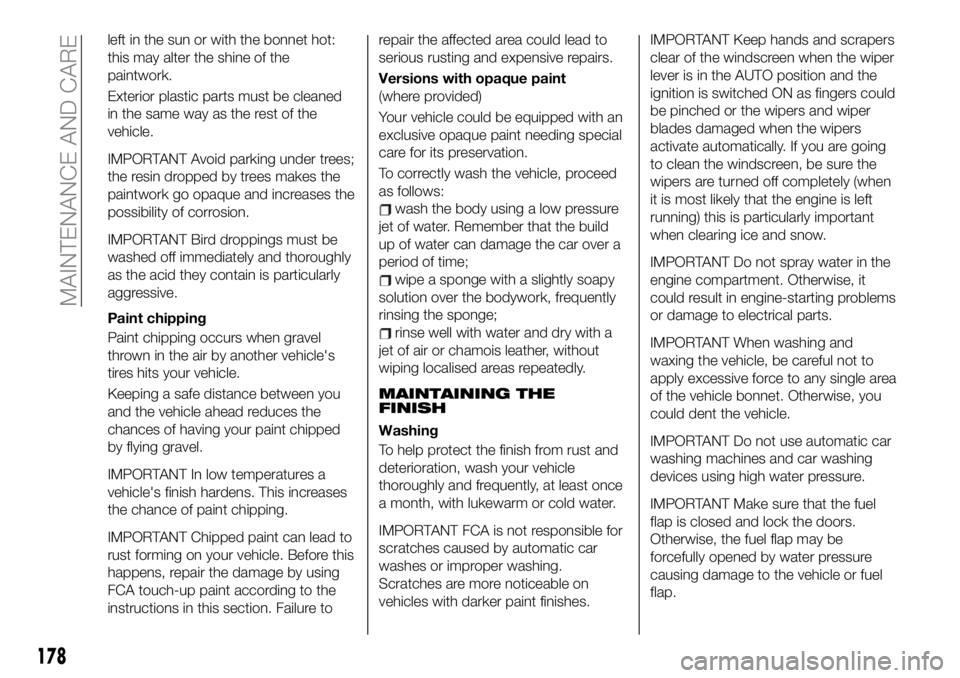
left in the sun or with the bonnet hot:
this may alter the shine of the
paintwork.
Exterior plastic parts must be cleaned
in the same way as the rest of the
vehicle.
IMPORTANT Avoid parking under trees;
the resin dropped by trees makes the
paintwork go opaque and increases the
possibility of corrosion.
IMPORTANT Bird droppings must be
washed off immediately and thoroughly
as the acid they contain is particularly
aggressive.
Paint chipping
Paint chipping occurs when gravel
thrown in the air by another vehicle's
tires hits your vehicle.
Keeping a safe distance between you
and the vehicle ahead reduces the
chances of having your paint chipped
by flying gravel.
IMPORTANT In low temperatures a
vehicle's finish hardens. This increases
the chance of paint chipping.
IMPORTANT Chipped paint can lead to
rust forming on your vehicle. Before this
happens, repair the damage by using
FCA touch-up paint according to the
instructions in this section. Failure torepair the affected area could lead to
serious rusting and expensive repairs.
Versions with opaque paint
(where provided)
Your vehicle could be equipped with an
exclusive opaque paint needing special
care for its preservation.
To correctly wash the vehicle, proceed
as follows:
wash the body using a low pressure
jet of water. Remember that the build
up of water can damage the car over a
period of time;
wipe a sponge with a slightly soapy
solution over the bodywork, frequently
rinsing the sponge;
rinse well with water and dry with a
jet of air or chamois leather, without
wiping localised areas repeatedly.
MAINTAINING THE
FINISH
Washing
To help protect the finish from rust and
deterioration, wash your vehicle
thoroughly and frequently, at least once
a month, with lukewarm or cold water.
IMPORTANT FCA is not responsible for
scratches caused by automatic car
washes or improper washing.
Scratches are more noticeable on
vehicles with darker paint finishes.IMPORTANT Keep hands and scrapers
clear of the windscreen when the wiper
lever is in the AUTO position and the
ignition is switched ON as fingers could
be pinched or the wipers and wiper
blades damaged when the wipers
activate automatically. If you are going
to clean the windscreen, be sure the
wipers are turned off completely (when
it is most likely that the engine is left
running) this is particularly important
when clearing ice and snow.
IMPORTANT Do not spray water in the
engine compartment. Otherwise, it
could result in engine-starting problems
or damage to electrical parts.
IMPORTANT When washing and
waxing the vehicle, be careful not to
apply excessive force to any single area
of the vehicle bonnet. Otherwise, you
could dent the vehicle.
IMPORTANT Do not use automatic car
washing machines and car washing
devices using high water pressure.
IMPORTANT Make sure that the fuel
flap is closed and lock the doors.
Otherwise, the fuel flap may be
forcefully opened by water pressure
causing damage to the vehicle or fuel
flap.
178
MAINTENANCE AND CARE